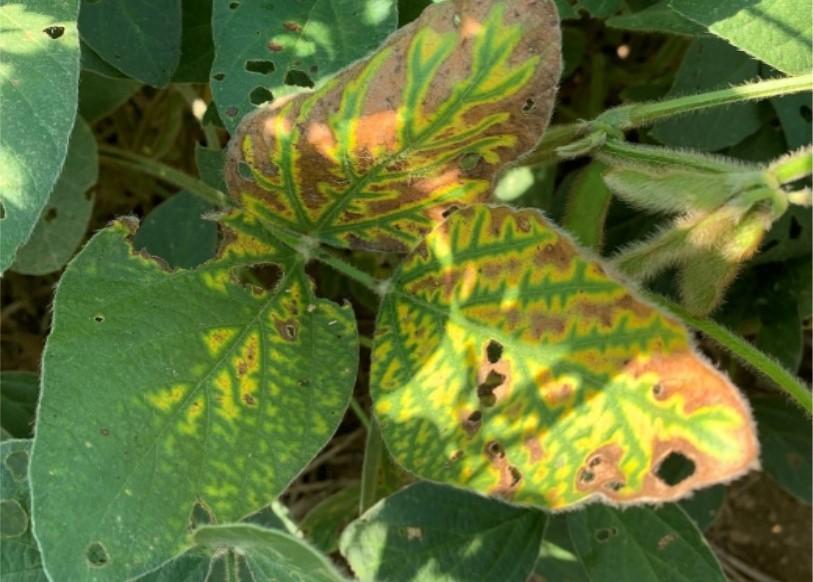Symptoms of Stem Diseases Developing in Soybean
As soybeans begin the pod fill growth stages, heat and drought stresses can trigger the development of many disease symptoms. Currently, we are seeing many instances of stem diseases in soybean. Many pathogens are associated with stem diseases in soybean, and many produce very similar foliar symptoms, which is why diagnosis from foliar symptoms alone typically leads to a misdiagnosis. Submit questionable samples to the UMD Plant Diagnostic Lab for proper identification. Common soybean stem diseases and their symptoms/signs are outlined below.
Sudden Death Syndrome (SDS)
Perhaps the most well-known stem disease is SDS. Symptoms of SDS include chlorosis between the veins of the leaf, which will eventually turn necrotic (Figure 1). The dead leaflets will fall off the plant but the petioles (leaf stems) remain attached to the plant. Discolored/brown tissue can be observed when stems are cut open near the base. Under moist conditions, you may also notice blue masses of spores near the base of the plant. Fields with soybean cyst nematode problems are often associated with higher occurrences of SDS.
Brown Stem Rot (BSR)
Foliar symptoms can look similar or identical to those of SDS. BSR exhibits dark brown discoloration in the center (pith) of the stem.
Charcoal Rot
Foliar symptoms can look very similar to SDS and BSR. When stems are split open, tiny black specks can be observed scattered on the stem and within the stem tissues. These black specks are microsclerotia.
Stem Canker/Stem Blight (Diaporthe)
Another common stem disease we are seeing this year is caused by various Diaporthe species. Foliar symptoms include general wilting and chlorosis as plants reach pod fill and will eventually die prematurely. When stems are split, well-defined “zone lines” can be observed embedded in the tissue (Figure 2).

Stem diseases are almost always observed on full-season soybeans. This is because all of these pathogens infect soybeans very early in the season (shortly after planting) when the soils are cool and wet, but plants do not exhibit symptoms until reproductive growth stages when the plants are under greater stress. Stressors include heat, drought, and pod fill. Infections can be more severe when we have wet, cool springs. The trend to plant soybeans earlier seems to be making these diseases more common since we are exposing seedlings to cooler, wetter soils, which favor infection.
Management of these diseases should include selecting resistant varieties (when possible), crop rotation, and planting into warmer soils whenever possible, especially if there is known history of stem diseases in a particular field. Some fungicide seed treatments may help delay early infections on early planted soybeans long enough until soil temperatures warm up. Foliar fungicides applied during reproductive stages do not have any effect on these diseases, as infection occurs through the roots when plants are very small.
This article appears on September 2021, Volume 12, Issue 6 of the Agronomy news.
